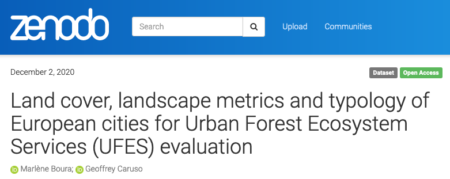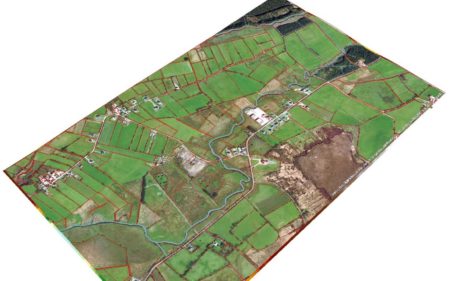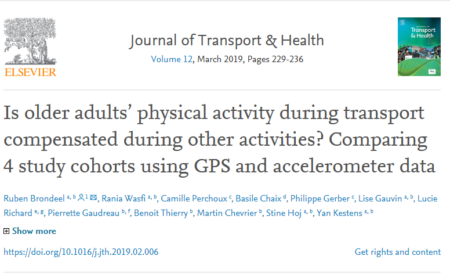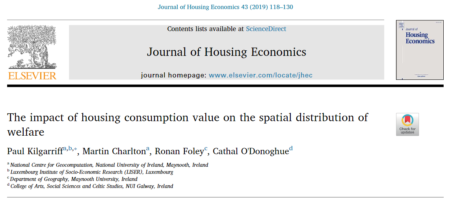Datasets by Marlène Boura and Geoffrey Caruso Zenodo: http://doi.org/10.5281/zenodo.4301952 Description The datasets provide a typology for 689 European urban areas, the land cover metrics and landscape metrics used to create the typology and the Urban Forest Ecosystem Services (UFES) indexes created from them. The typology of Urban Forest Ecosystem Services (UFES) presents 10 clusters of
CategoryPublication
For posts describing a recent article/ WP publication
Urban Interventions to Reduce Pollution Exposure and Improve Spatial Equity
New publication by Mirjam Schindler and Geoffrey Caruso Abstract Air pollution is of increasing concern to urban residents and urban planners are struggling to find interventions which tackle the trade‐off between environmental, health, and economic impacts arising from this. We analyze within a spatially explicit theoretical residential choice model how different urban interventions can reduce
Les dimensions spatiales et socioprofessionnelles du travail frontalier aux frontières franco-suisse et franco-luxembourgeoise
I. Pigeron-Piroth et R. Belkacem, Geo-Regards n° 13/2020 Cet article analyse les principales dimensions spatiales et socioprofessionnelles des travailleurs frontaliers aux différentes frontières de la France, notamment au sein des pôles d’emploi transfrontaliers de Genève, Bâle et de Luxembourg. Il s’appuie sur une exploitation des données du recensement français de la population, complétées par les
Creating a Spatial National Farm Database for Policy Analysis
Examine the impact of bovines on watercourses This article appeared on Teagasc Daily 4th June 2020 Background: Water Quality in Ireland and EU Directives The European Union (EU) has introduced a number of directives aimed at improving water quality, such as the Nitrates Directive (ND) (91/676/EEC) and Water Framework Directive (WFD) (2000/60/EC). The WFD set
Activity spaces in place and health research: Novel exposure measures, data collection tools, and designs
So excited to see our paper on “Activity spaces in place and health research” published in Health and Place, with Basile Chaix and Yan Kestens : https://doi.org/10.1016/j.healthplace.2019.05.008 Free access until October 9th, 2019: https://authors.elsevier.com/a/1ZbT5_Uo5A~6R5 Our commentary answers a systematic review from Lindsey Smith, Louise Foley and Jenna Panther on “Activity spaces in studies of the environment
When motility and movement meet wellbeing
Check out our new CURHA (Contrasting Urban Environments and Healthy Ageing, FNR-IRSC-FRSQ project) paper on links between mobility and wellbeing among older adults in Luxembourg ! We used the concept of motility, estimated in a structural equation model, in order to disentangle the complex relationships between locations, geographic environments and daily mobility related to wellbeing.
Walking, trip purpose, and exposure to multiple environments
Check out our new CURHA paper on neighborhood effect on walking! We used an activity space approach to explore the relationships between environmental conditions around and between activity locations, trip purpose and walking. Specific attention was dedicated to the role played by “trip purpose” on the i) the odds of walking, and ii) as a
Is older adults’ physical activity during transport compensated during other activities?
Check out our new CURHA paper, led by Dr. Ruben Brondeel, and comparing 4 study cohorts using GPS and accelerometers ! https://www.sciencedirect.com/science/article/pii/S2214140518305048 Abstract Introduction Promoting active transport offers the potential to increase population physical activity levels. Compensation theories state that above-average physical activity in one activity is compensated in later activities; a mechanism that results
For policy-relevant measures, it is important that policymakers are able to foresee how quality improvements influence the price of land, over time and space.
Abstract Urban development projects have many effects on society, such as improving mobility, health, education, and sustainability. For policy-relevant measures, it is important that policymakers are able to foresee how quality improvements influence the price of land. Therefore, our objective is to collect a set of variables able to account for the effects of a multitude of land
Dis-equalising impact of Housing
https://www.sciencedirect.com/science/article/pii/S1051137718301293 The measure of a household’s income should include not only monetary components such as job salary but also non-monetary components and in-kind benefits, such as imputed rent. Imputed rent is the rent an owner can expect to receive were the house on the rental market. Being an owner-occupier does not provide a rental income







